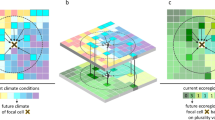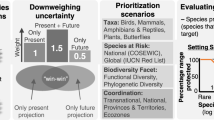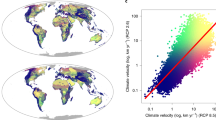Abstract
Protected areas are a fundamental mechanism for conserving global biodiversity. Given limited conservation funds and shortfalls in funding for existing protected area management needs, a critical question is: should countries and states spend new funds on purchasing more land or managing existing protected areas to an acceptable standard? We used a non-spatial dynamic landscape model to compare the relative importance of expansion of protected areas versus improved protected area management in diverse contexts. We provide guidance on how to allocate funding across these two actions, and the order in which these actions should be prioritized. We discover that, in contrast with spending patterns, which focus on expansion rather than management, management is often the better first investment. The relative priority of expansion and management is determined by observable factors: the relative costs of the two actions and rates of degradation in protected and unprotected areas. Importantly, regardless of these factors, the final recommended action is always to split the budget across expansion and management such that there is adequate money for management. This highlights that, while our existing protected areas are an important asset, increased investment in management is essential to maximize their potential to protect biodiversity.
This is a preview of subscription content, access via your institution
Access options
Access Nature and 54 other Nature Portfolio journals
Get Nature+, our best-value online-access subscription
$29.99 / 30 days
cancel any time
Subscribe to this journal
Receive 12 digital issues and online access to articles
$119.00 per year
only $9.92 per issue
Buy this article
- Purchase on Springer Link
- Instant access to full article PDF
Prices may be subject to local taxes which are calculated during checkout




Similar content being viewed by others
Data availability
All relevant data are within the paper and its Supplementary Information.
Code availability
The MATLAB code is available from the authors on request.
References
Brooks, T. M. et al. Global biodiversity conservation priorities. Science 313, 58–61 (2006).
Butchart, S. H. M. et al. Global biodiversity: indicators of recent declines. Science 328, 1164–1168 (2010).
Rodrigues, A. S. L. et al. Global gap analysis: priority regions for expanding the global protected-area network. Bioscience 54, 1092–1100 (2004).
Watson, J. E. M., Dudley, N., Segan, D. B. & Hockings, M. The performance and potential of protected areas. Nature 515, 67–73 (2014).
Convention on Biological Diversity—Aichi Biodiversity Targets (CBD, 2010).
Woodley, S. et al. Meeting Aichi target 11: what does success look like for protected area systems. Parks 18, 23–36 (2012).
Butchart, S. H. M. et al. Shortfalls and solutions for meeting national and global conservation area targets. Conserv. Lett. 8, 329–337 (2015).
Leverington, F., Costa, K. L., Pavese, H., Lisle, A. & Hockings, M. A global analysis of protected area management effectiveness. Environ. Manage. 46, 685–698 (2010).
Barnes, M. D., Craigie, I. D., Dudley, N. & Hockings, M. Understanding local-scale drivers of biodiversity outcomes in terrestrial protected areas. Ann. NY Acad. Sci. 1399, 42–60 (2017).
Coad, L. et al. Progress towards the CBD protected area management effectiveness targets. Parks 19, 13–24 (2013).
Geldmann, J. et al. Effectiveness of terrestrial protected areas in reducing habitat loss and population declines. Biol. Conserv. 161, 230–238 (2013).
Preparations for the Post-2020 Biodiversity Framework (CBD, 2018); https://www.cbd.int/post2020/
Mascia, M. B. & Pailler, S. Protected area downgrading, downsizing, and degazettement (PADDD) and its conservation implications. Conserv. Lett 4, 9–20 (2011).
Mascia, M. B. Protected area downgrading, downsizing, and degazettement (PADDD) in Africa, Asia, and Latin America and the Caribbean, 1900–2010. Biol. Conserv. 169, 355–361 (2014).
Jones, K. R. et al. One-third of global protected land is under intense human pressure. Science 360, 788–791 (2018).
Joppa, L. N. & Pfaff, A. Global protected area impacts. Proc. R. Soc. B 278, 1633–1638 (2010).
Ferraro, P. J. et al. More strictly protected areas are not necessarily more protective: evidence from Bolivia, Costa Rica, Indonesia, and Thailand. Environ. Res. Lett. 8, 025011 (2013).
Bowker, J. N., De Vos, A., Ament, J. M. & Cumming, G. S. Effectiveness of Africa’s tropical protected areas for maintaining forest cover. Conserv. Biol. 31, 559–569 (2017).
Barnes, M. D. et al. Wildlife population trends in protected areas predicted by national socio-economic metrics and body size. Nat. Commun. 7, 12747 (2016).
Geldmann, J. et al. Changes in protected area management effectiveness over time: a global analysis. Biol. Conserv. 191, 692–699 (2015).
Maxwell, S. L., Fuller, R., Brooks, T. & Watson, J. The ravages of guns, nets and bulldozers. Nature 536, 143–145 (2016).
Nicholson, E. et al. Making robust policy decisions using global biodiversity indicators. PLoS ONE 7, e41128 (2012).
Geldmann, J. et al. A global analysis of management capacity and ecological outcomes in terrestrial protected areas. Conserv. Lett. 11, e12434 (2018).
Barnes, M. D., Glew, L., Wyborn, C. & Craigie, I. D. Prevent perverse outcomes from global protected area policy. Nat. Ecol. Evol. 2, 759–762 (2018).
McCarthy, D. P. et al. Financial costs of meeting global biodiversity conservation targets: current spending and unmet needs. Science 338, 946–949 (2012).
Bruner, A. G., Gullison, R. E. & Balmford, A. Financial costs and shortfalls of managing and expanding protected-area systems in developing countries. Bioscience 54, 1119–1126 (2004).
Radeloff, V. C. et al. Hot moments for biodiversity conservation. Conserv. Lett. 6, 58–65 (2013).
Alaska National Interest Lands Conservation Act Public Law 96-487 (Senate and House of Representatives of the United States of America, 1980); (http://dnr.alaska.gov/commis/opmp/anilca/pdf/PublicLaw-96-487.pdf
Budget 2016-17: Budget Measures Budget Paper No. 2 (Australian Government, 2016); https://www.budget.gov.au/2016-17/content/bp2/html/bp2_expense-12.htm.
Redford, K. H. The empty forest. Bioscience 42, 412–422 (1992).
Venter, O. et al. Targeting global protected area expansion for imperiled biodiversity. PLoS Biol. 12, e1001891 (2014).
Gill, D. A. et al. Capacity shortfalls hinder the performance of marine protected areas globally. Nature 543, 665–669 (2017).
Schulze, K. et al. An assessment of threats to terrestrial protected areas. Conserv. Lett. 11, e12435 (2017).
Myers, N., Mittermeier, R. A., Mittermeier, C. G., da Fonseca, G. A. B. & Kent, J. Biodiversity hotspots for conservation priorities. Nature 403, 853–858 (2000).
Bode, M. et al. Cost-effective global conservation spending is robust to taxonomic group. Proc. Natl Acad. Sci. USA 105, 6498–6501 (2008).
Gurevitch, J. & Padilla, D. K. Are invasive species a major cause of extinctions? Trends Ecol. Evol. 19, 470–474 (2004).
Levine, J. M. et al. Mechanisms underlying the impacts of exotic plant invasions. Proc. R. Soc. Lond. B 270, 775–781 (2003).
Grice, A. C. The impacts of invasive plant species on the biodiversity of Australian rangelands. Rangeland J. 28, 27–35 (2006).
Holt, R. D., Lawton, J. H., Polis, G. A. & Martinez, N. D. Trophic rank and the species–area relationship. Ecology 80, 1495–1504 (1999).
Benchimol, M. & Peres, C. A. Anthropogenic modulators of species–area relationships in Neotropical primates: a continental-scale analysis of fragmented forest landscapes. Divers. Distrib. 19, 1339–1352 (2013).
Sreekar, R. et al. The use of species–area relationships to partition the effects of hunting and deforestation on bird extirpations in a fragmented landscape. Divers. Distrib. 21, 441–450 (2015).
Kuempel, C. D., Adams, V. M., Possingham, H. P. & Bode, M. Bigger or better: the relative benefits of protected area network expansion and enforcement for the conservation of an exploited species. Conserv. Lett. 11, e12433 (2018).
Rapid Review of Conservation Trust Funds (Conservation Finance Alliance, 2008).
Bladon, A., Mohammed, E. Y. & Milner-Gulland, E. J. A Review of Conservation Trust Funds for Sustainable Marine Resources Management: Conditions for Success (International Institute for Environment and Development, 2014).
Bonham, C. et al. Conservation trust funds, protected area management effectiveness and conservation outcomes: lessons from the Global Conservation Fund. Parks 20, 89–101 (2014).
Iacona, G., Hall, I. & Wilson, K. in Decision Point Vol. 64 4–5 (EDG, 2015).
Financing Protected Areas: Guidelines for Protected Area Managers (IUCN, 2000).
Maron, M., Simmonds, J. S. & Watson, J. E. M. Bold nature retention targets are essential for the global environment agenda. Nat. Ecol. Evol. 2, 1194–1195 (2018).
Wilson, K. A. et al. Conserving biodiversity in production landscapes. Ecol. Appl. 20, 1721–1732 (2010).
Possingham, H. P., Bode, M. & Klein, C. J. Optimal conservation outcomes require both restoration and protection. PLoS Biol. 13, e1002052 (2015).
Rodrigues, A. S. L. et al. Spatially explicit trends in the global conservation status of vertebrates. PLoS ONE 9, e113934 (2014).
Armsworth, P. R. Inclusion of costs in conservation planning depends on limited datasets and hopeful assumptions. Ann. NY Acad. Sci. 1322, 61–76 (2014).
Burgman, M. A., Keith, D., Hopper, S. D., Widyatmoko, D. & Drill, C. Threat syndromes and conservation of the Australian flora. Biol. Conserv. 134, 73–82 (2007).
Kuussaari, M. et al. Extinction debt: a challenge for biodiversity conservation. Trends Ecol. Evol. 24, 564–571 (2009).
Knapp, E. J., Rentsch, D., Schmitt, J., Lewis, C. & Polasky, S. A tale of three villages: choosing an effective method for assessing poaching levels in western Serengeti, Tanzania. Oryx 44, 178–184 (2010).
Marshall, A. R. et al. The species–area relationship and confounding variables in a threatened monkey community. Am. J. Primatol. 72, 325–336 (2010).
Acknowledgements
V.M.A., G.D.I. and H.P.P. were funded by the Australian Research Council (http://www.arc.gov.au). H.P.P. was funded by an Australian Research Council Laureate Fellowship.
Author information
Authors and Affiliations
Contributions
V.M.A., G.D.I. and H.P.P. developed the initial idea. V.M.A. designed and ran the simulations. V.M.A., G.D.I. and H.P.P. wrote the paper.
Corresponding author
Ethics declarations
Competing interests
The authors declare no competing interests.
Additional information
Publisher’s note: Springer Nature remains neutral with regard to jurisdictional claims in published maps and institutional affiliations.
Supplementary information
Supplementary Information
Supplementary methods, Supplementary Figs. 1–5, Supplementary Table 1, Supplementary references 1–6
Rights and permissions
About this article
Cite this article
Adams, V.M., Iacona, G.D. & Possingham, H.P. Weighing the benefits of expanding protected areas versus managing existing ones. Nat Sustain 2, 404–411 (2019). https://doi.org/10.1038/s41893-019-0275-5
Received:
Accepted:
Published:
Issue Date:
DOI: https://doi.org/10.1038/s41893-019-0275-5
This article is cited by
-
Global conservation priorities for wetlands and setting post-2025 targets
Communications Earth & Environment (2024)
-
Community Perception and Management of Ecosystem Services in a Protected Area in Kashmir Himalaya
Human Ecology (2023)
-
Strategic planning to mitigate mining impacts on protected areas in the Brazilian Amazon
Nature Sustainability (2022)
-
Surrogacy of bird species in systematic conservation planning and conservation assessments in Yunnan Province, China
Journal of Mountain Science (2022)
-
Challenges and opportunities of area-based conservation in reaching biodiversity and sustainability goals
Biodiversity and Conservation (2022)



